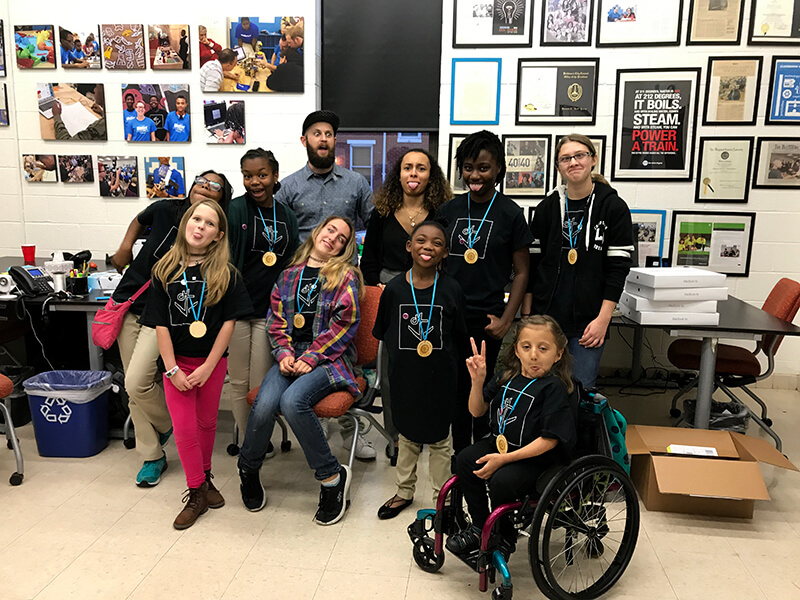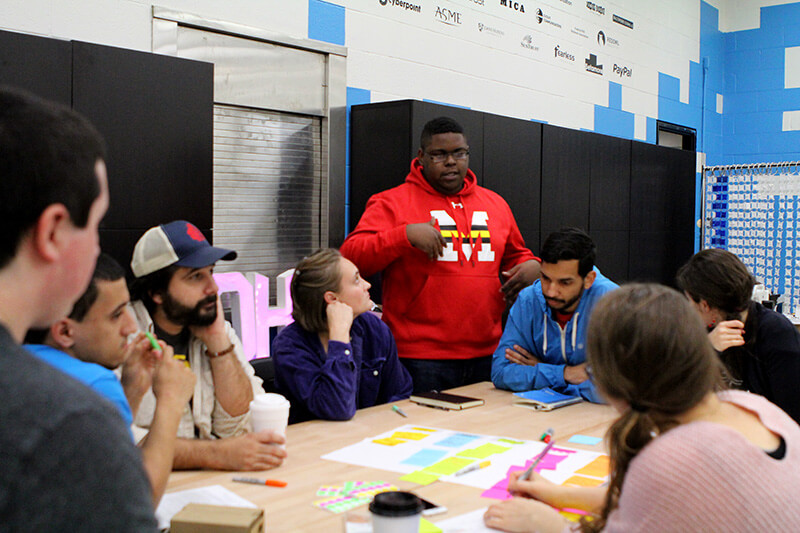Case Example
Youth-led Advisory Boards to Promote Youth Leadership
Anthony Pellicone - University of Wisconsin-Madison
Rafi Santo - New York University
Youth input on programming, especially in new areas like digital learning, is vital to maintaining a responsive environment for learners. This resource explores how organizations support youth to steer programs through the formation of youth advisory boards.

What’s the Issue?
Youth input on educational programs, policies, and personnel is vital to maintaining a responsive and engaging environment for young learners. However there are often tensions and challenges to fully and authentically incorporating youth perspectives into a program. This resource looks at cases where organizations have developed ways to allow youth to steer programs through the formation of youth advisory boards.
We share an example of what this can look like through the work the Digital Harbor Foundation (DHF) in Baltimore, Maryland, where a group of motivated youth started a working group dedicated to increasing the gender diversity in the technology-focused programs that DHF offers. We then explore tensions and challenges, along with questions to consider in your organization if you’re considering using this approach.
What Does it Look Like?
At Digital Harbor Foundation in Baltimore, a group of youth led an effort to address a long-standing problem: the gender gap in technology sectors. A passionate, young female participant created a female and non-binary working group, called The Makerettes. With DHF’s support, this group eventually led to a more gender diverse cohort of participants than any of DHF’s existing programs.
DHF has a youth advisory board, which is a formalized part of their organizational structure. A female participant in the advisory board recognized the gender disparity in broader DHF program participation and worked to correct it. Steph Grimes, one of DHF’s leaders, described it this way:
Of the girls in my cohort, there [were] three of us who were here regularly. Out of, at that point, maybe 40, 50 kids on and off? So we formed an all girls group. The staff supported [the teen that suggested the idea] in that, and it was something she and I worked on. The girls could get together, and have special meetings that were just for the girls. Then they would share with the new incoming girls through Maker Foundations [DHF’s introductory course offering].
[We used that as a hook] for getting girls in Maker Foundations, saying, “Hey if you’re part of this program you can be part of this cool club, too.” They were just doing special projects on their own. It started as this really sort of informal thing that one of our youth really cared about and was passionate about. Since Mary [a DHF educator] came on she has taken it and gone miles and miles further with it, which is awesome. And then from that we said, “What if we did an all girls cohort?” So you know, we run two cohorts of Maker Foundations at a time, what if we have one of those, so two days a week, all girls? So we tried that. And it went awesome.

Guiding Questions
- How can adults and youth divide labor in cooperative ways on a youth advisory board?
- If youth suggest something, are there avenues of participation that allow for that suggestion to have an effect in the larger organization?
- What are developmentally appropriate leadership tasks for the youth you serve?
- Are you able to give youth needed supports and in some way acknowledge or even compensate them for their work in an advisory board?
This success was spurred by the initiative of a single program participant, who recruited her friends, and who, in turn, mobilized to create the largest female cohort the program had ever seen. Eventually it was integrated into a co-ed cohort. Shawn, another DHF leader, describes it as such: “We ended up with the highest mix of girls in our co-ed cohort that semester as well, which was really interesting. Somehow the all girls cohort propelled enrollment for females in the co-ed cohorts.” All of this came from a standing structure within DHF to maintain and nurture a youth advisory board, giving participants the initial platform and power to address a problem that they perceived with the program.
Beyond the example of The Makerettes, Steph at DHF also relays how their Youth Steering board has helped them to structure their programmatic offerings so that they fit the day-to-day lives of older teen participants:
As they’ve gotten older, some of them have trickled into high school. e just had our first big rush go into high school this fall. he feedback we’re hearing from them is we need to have programs later in the day. Teens still want to come, but some students don’t get out of school until 4:00 or 4:30, meaning they can’t arrive until 5:00. One of the things that we’re considering for the fall is extending the program to go until 7:00.
From addressing issues of gender disparity to adjusting programs to fit the schedules of youth, an active youth advisory created the conditions for greater ownership and equity for participants, as well as programming decisions that were more aligned to youth needs.
What Does it Lead to?
Thomas Akiva, a noted youth development scholar, conducted research that presents several different benefits of involving youth in programmatic decision making (see this 2014 journal article for more information) :
- Developmental benefits. Teens are often entering a stage of life where they are making more decisions and want to experience leading and working as a team. Often this opportunity is lacking, as formalized avenues (e.g. student government) may be heavily constrained and not be seen as meaningful by students.
- Increased motivation. Youth involvement may also lead to greater buy-in, as well as greater ownership and engagement with program experiences. Increased motivation due to greater levels of leadership has also been shown to improve retention among youth participants of informal learning.
- Skills acquisition. The skills of working on a youth advisory board are well aligned with what we might think of as ‘workplace’ skills, such as planning, communication, and collaboration. Beyond workplace concerns, experience with leadership is personally rewarding. It can help youth to build identities as leaders as well as belief in their ability to affect change in the world.
- Civic participation. Youth boards provide early experience with participatory, direct influence on a system, which can be argued is a pathway to later forms of civic participation.
In a survey of 979 youth across 63 institutions, Akiva, Cortina and Smith find generally that sharing decision making with youth is associated with higher levels of motivation across all age ranges. For older participants there are also gains in the civic, socio-emotional skills, and decision making, corroborating previous research that suggests that these benefits tend to occur more fruitfully further along the development spectrum as participants reach high school age:
Indeed, if adolescent identity development involves a tension between maintaining and exploring one’s identity…offering adolescents the opportunity to make meaningful decisions about the operation of a youth program may allow for this exploration in a safe and authentic context, along with potentially providing a context for the development of skills like responsibility. (Akiva, Cortina, & Smith, 2014).
At the same time, there is also a recognition that not all youth advisory is equivalent: facile or superficial involvement may actually serve to negatively impact youth development along the above categories.
Additionally, these structures have benefits not just for the youth, but also for the programs themselves. As The Makerettes at DHF show, youth understand the gaps in service of current program offerings. The youth advisory board gives them opportunities to bridge those gaps.

Related Resources
YALSA – Teen Advisory Boards and Library Programs
YALSA – Teen Programming Guidelines
YALSA – Teen Activist Boards
Akiva, Cortina & Smith (2014) article “Involving Youth in Program Decision-Making: How Common and What Might it Do for Youth?”
Tensions and Challenges
An important aspect with structuring advisory boards is to realize that there must be meaningful participation for teens, but it may not always be best to have advisory boards actively making decisions about high stakes issues in an organization. While advisory boards are generally beneficial, work that isn’t age appropriate or work that isn’t directed at a relevant and meaningful goal will actually have adverse effects on youth involvement. Striking this balance can be difficult to achieve. Jeff, the Director of Free Spirit Media in Chicago, describes his organization’s youth advisory boards:
We’ve had a youth counsel for maybe five or six years. Informally we always had conversations and focus groups and also just informal feedback, like, ‘Hey, should we do this?,’ and, ‘What’s working here and what’s not?’ But we started the formal youth board with the goal to be a leadership body and a driver of innovation in the organization. Sometimes, however, based on capacity and time available, it has become more of an event planning group. They’ll plan a showcase where we show videos and they’ll plan a field day where all the programs in the summer get together and play games and get to know each other more.
Jeff’s perspective here highlights a vital aspect of this practice. These sub-organizations are less formal and rigid than in the adult world, but it also takes effort to ensure that a youth board is playing an authentic and meaningful role. This is also visible in the example from DHF, where The Makerettes focused on a specific problem that they wanted to solve. Great care and experienced, professional guidance from your educators are needed to help youth boards focus on deeply meaningful change, rather than focusing on smaller issues that may seem substantial but are not that influential to improving their learning experiences.